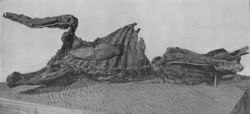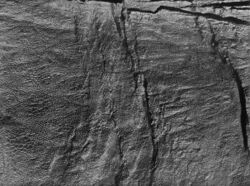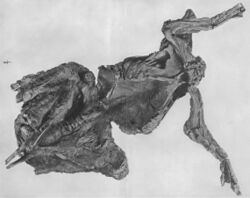Earth:Trachodon mummy
The Trachodon mummy is a fossilized natural mummy of Edmontosaurus annectens (originally known as Trachodon annectens), a duckbilled dinosaur. One of the finest dinosaur specimens so far discovered, it was the first including a skeleton encased in skin impressions from large parts of the body. This specimen has considerably influenced the scientific conception of duckbilled dinosaurs. Skin impressions found in between the fingers have been interpreted as evidence for an aquatic lifestyle; this hypothesis is now rejected. The mummy was found by fossil hunter Charles Hazelius Sternberg and his three sons near Lusk, Wyoming, United States in 1908. Although Sternberg was working under contract to the British Museum of Natural History, Henry Fairfield Osborn of the American Museum of Natural History managed to secure the mummy.
Discovery
thumb|Badlands of the Lance-Formation along the Cow Creek in Wyoming The Trachodon mummy was discovered and excavated in 1908 by Charles Hazelius Sternberg and his three sons George, Charles Jr. and Levi. An independent fossil collector, Sternberg offered his finds to various museums in North America and Europe for sale. The sons worked as assistants for their father, but later ascended to renowned paleontologists.[1] Early in 1908, Sternberg planned an expedition to the Lance Creek area in eastern Wyoming, where the family had not worked before. In search for acquirers of potential fossil finds, he wrote to the British Museum of Natural History that he would know where in Wyoming to find a skull of the horned dinosaur Triceratops, knowing that the museum was lacking a good specimen; the museum agreed to buy up any good fossil finds if such would be made.[2][3] Finally, the Sternberg expedition left its family residence in Kansas in early spring,[2] and arrived in the Lance Creek area in July.[4] Sternberg's plan foresaw the exploration of an uninhabited area of approximately 1000 square miles (2590 km²) north to the North Platte River and south to the Cheyenne River in Converse County (today Niobrara County).[2][4] The predominant badlands of this area expose sedimentary rocks of the Maastrichtian stage of the Upper Cretaceous, which today are known as the Lance Formation. The area had already been intensively explored by paleontological expeditions; before the start of his expedition, Sternberg learned that the American Museum of Natural History was unsuccessfully working in the area for years.[4]
The first weeks of search remained unsuccessful.[4] Sternberg wrote: "Day after day hoping against hope we struggled bravely on. Every night the boys gave answer to my anxious inquiry, What have you found? Nothing."[4] End of August, Sternberg finally discovered a fossil horn weathering out of the rock; subsequent excavation unearthed a 198 cm long Triceratops skull.[4][5] Soon after, George, the oldest son, found bones sticking out of the rock while prospecting new territory with Levi, the youngest son. Levi discovered additional bones nearby, apparently belonging to the same skeleton. At this point of time, the group has departed 65 miles (105 km) from its base camp, and food reserves became scarce. Sternberg instructed George and Levi to carefully remove the sandstone above the skeleton, and himself set of for Lusk together with Charles Jr., in order to purchase new supplies and to initiate the shipping of the Triceratops skull to the British Museum. At the third day after their father's departure, George and Levi already had found out their find was an apparently complete skeleton lying on its back. When removing a large piece of sandstone from the chest region of the specimen, George discovered, to his surprise, a perfectly preserved skin impression. In 1930, George remembered: "Imagine the feeling that crept over me when I realized that here for the first time a skeleton of a dinosaur had been discovered wrapped in its skin. That was a sleepless night for me."[1] When Sternberg finally returned at the fifth day, George and Levi had run out of food, and had to feed on unsalted potatoes for the last two days. Nevertheless, they had completely removed the overburden, exposing the skeleton; the dig measured 3.6 m in width, 4.5 m in length and 3 m in depth.[2][4]
When paleontologist Henry Fairfield Osborn, manager of the American Museum of Natural History, learned about the new find, he immediately sent staff member and paleontologist Albert Thomson, to possibly secure it for the museum. Osborn knew about the agreement between Sternberg and the British Museum, which gives the latter dibs to acquire any of the finds; he however appealed to Sternbergs patriotism and promised permanent exhibition of the fossil.[2] When Thomson arrived, the mummy had already been wrapped in burlap and shellac for transport. Due to the high asking price of $2,000, Thomson was unable to evaluate the fossil. On the same day as Thomson, William Jacob Holland, director of the Carnegie Museum of Natural History, arrived at Lusk; Osborn, now worried about losing his opportunity, quickly acquired the specimen for an unknown sum.[6][7]
In the American Museum, preparation of the skin impressions was completed by preparator Otto Falkenbach;[8] subsequently, it was scientifically described by Osborn himself and the famous paleontologist Barnum Brown, and afterwards was put on display. In the exhibition, the mummy, protected by a glass showcase, is shown lying on its back as it was discovered; the museum decided to abstain from restoring missing parts.[2][7] Today, the mummy is regarded as one of the museum's most important fossils.[3]
Significance and classification
The scientific value of the mummy lies in its exceptionally high degree of preservation, the articulation of the bones in their original anatomical position, and the extensive skin impressions enveloping the specimen. In 1911, Osborn rhapsodized: "This truly wonderful specimen, therefore, nearly doubles our previous insight into the habits and life of a very remarkable group of reptiles."[9] As dinosaur skin impressions were previously known only from few fragments, the Trachodon mummy became a paleontological sensation.[1] As noted by Osborn in 1912, however, the famous holotype specimen of Trachodon mirabilis (AMNH 5730), found in 1884 by Jacob Wortman, originally also contained extensive skin impressions. Most of these impressions had been destroyed during excavation, with only three fragments from the tail region remaining. As explained by Osborn, the very thin layer containing the skin impressions in the stone is difficult to detect, and many such impressions might have been lost in previous years as they were not expected nor recognized by excavators.[8]
The Trachodon mummy belongs within the Hadrosauridae ("duck-billed dinosaurs"), a family of ornithischian ("bird-hipped") dinosaurs. Barnum Brown initially identified the mummy as Trachodon annectens. At the time, the genus Trachodon encompassed nearly all known hadrosaurid specimens.[10] Since 1942, the mummy was referred to the new species Anatosaurus copei,[11] which in 1990 was externalized in its own genus, Anatotitan.[12] Anatotitan copei now is regarded a synonym of Edmontosaurus annectens by most researchers.[13] The majority of dinosaur skin impressions is referable to the Hadrosauridae. In the Maastrichtian age of North America, skin impressions are 31 times more abundant in association with hadrosaurid specimens than with any other group. The reasons for this distribution is unclear. Of all known hadrosaurid skin impressions, 25% are referred to Edmontosaurus.[14]
Description and interpretation
thumb|Outline drawing of the mummy in ventral view Most of the skeleton is preserved, with the bones still attached to each other in their original anatomical position. The tail, hind feet, and hind portion of the pelvis had eroded away before the mummy was discovered. Frequently, fossils become flattened during fossilization; the Trachodon mummy, however, is preserved three-dimensionally, without significant deformation.[15] The specimen was found lying on its back, with head and neck being twisted downwards and to the right side of the body. Both knees were drawn forwards, while the forelimbs struck out into the air.[8] Almost two thirds of the total skin area are preserved, often with excellent preservation, leading Osborn to coin the term dinosaur mummy.[9] The skin impressions are pressed tightly onto the bones, and are partially drawn into the body in between the bones. Upon its discovery, skin impressions probably encased the whole skeleton but have been partially destroyed while it was freed from the surrounding rocks.[8] Skin impressions are preserved on the forelimbs, neck and throat, the chest, as well as on the right side of the trunk.[8] In addition to the skin impressions, Sternberg noted the preservation of muscle impressions.[5] In 2007, paleontologist Kenneth Carpenter suggested that even impressions of inner organs might have been preserved; this possibility however cannot be evaluated without detailed computer tomography and x-ray analyses.[15]
Skin
thumb|Drawing of skin impressions from the underside of the trunk In relation to the animal's body size, the skin appears very thin and delicate. As typical for non-feathered dinosaurs, the skin consisted of non-overlapping scales called tubercles. Two sorts of tubercles can be found: The small (1 to 3 mm in diameter) rounded ground tubercles, which are evenly distributed, form the ground plan. The larger (less than 5 mm in diameter) pavement tubercles are pentagonal in shape, raised relative to the ground tubercles, and arranged in irregular clusters interrupting the ground plan. The clusters consist of between twenty and several hundreds of individual pavement tubercles, and are bordered by intermediate tubercles which mediate in size and shape between ground and pavement tubercles. In the chest- and abdominal region, clusters are small, oval in shape and arranged in irregular longitudinal lines. They become larger towards the sides of the trunk, where they reach 5 to 10 mm in diameter; their shape becomes more irregular. The largest clusters can be found above the pelvis and measure 50 cm in diameter; presumably, clusters of similar size were present along the animal's back.[8]
The hands of the Edmontosaurus and other species unearthed later suggested the presence of webbed feet, but was later found to be inconsistent with footprint evidence. It has since then been proposed that hadrosaur forefeet have a hard, horseshoe-shaped pad. The webbed skin was later found to be from the postmortem displacement of loose skin of the hand.
Osborn's description
In 1912, Osborn came up with a description of the fossil and a theory to its mummification:
After a natural death (in other words, not death by predators) the body lay exposed to the sun for a long time, perhaps on a sand bar or in a stream. The muscles and soft internal tissues became completely dried and shrunken while the skin, hardened and leathery, shrank around the limbs and was drawn down along the bones. In the stomach and abdominal areas the skin was drawn within the body cavity, while along the sides of the body and on the arms, it was formed into creases and folds. At some later date, the "mummy" may have been caught in a sudden flood and carried downstream and rapidly buried in fine sand and clay. A cast, or impression, of the skin formed in the sand before the skin and other soft parts decayed. There is no remnant of the actual skin preserved, only its imprint.
See also
- Timeline of hadrosaur research
- Malta, Montana, where mummified Brachylophosaurus "Leonardo" was discovered
References
- ↑ 1.0 1.1 1.2 Colbert, Edwin Harris (1984). The Great Dinosaur Hunters and Their Discoveries. Courier Dover Publications. pp. 184, 195–197. ISBN 0-486-24701-5.
- ↑ 2.0 2.1 2.2 2.3 2.4 2.5 Rogers, Katherine (1999). The Sternberg Fossil Hunters: A Dinosaur Dynasty. Mountain Press Publishing Company. pp. 107–108, 110–115. ISBN 0-878-42404-0.
- ↑ 3.0 3.1 Preston, Douglas (1993). "Sternberg and the dinosaur mummy". Dinosaurs in the Attic: An Excursion Into The American Museum of Natural History. United States: Macmillan Publishers. pp. 73–77. ISBN 0-312-10456-1.
- ↑ 4.0 4.1 4.2 4.3 4.4 4.5 4.6 Sternberg, Charles H. (1909). The Life of a Fossil Hunter. New York: Henry Holt and Company. pp. 270–277.
- ↑ 5.0 5.1 Sternberg, Charles H. (1909). "Expedition to the Laramie Beds of Converse County, Wyoming". Transactions of the Kansas Academy of Science 22: 113–116. doi:10.2307/3624729.
- ↑ Switek, Brian. "How Much for a Mummy Dinosaur?". http://www.smithsonianmag.com/science-nature/how-much-for-a-mummy-dinosaur-32984702/?no-ist.
- ↑ 7.0 7.1 Norell, Mark A.; Gaffney, Eugène S.; Dingus, Lowell (2000). "Edmontosaurus annectens". Discovering Dinosaurs: Evolution, Extinction, and the Lessons of Pre-History. University of California Press. pp. 154–155. ISBN 0-520-22501-5.
- ↑ 8.0 8.1 8.2 8.3 8.4 8.5 Osborn, Henry Fairfield (1912). "Integument of the iguanodont dinosaur Trachodon". Memoirs of the American Museum of Natural History 1: 33–35, 46–54.
- ↑ 9.0 9.1 Osborn, Henry Fairfield (1911). "A Dinosaur Mummy". The American Museum Journal (New York) 11: 7–11.
- ↑ Creisler, Benjamin S. (2007). "Deciphering duckbills: a history in nomenclature". in Carpenter, Kenneth. Horns and Beaks. Ceratopsian and Ornithopod Dinosaurs. Bloomington: Indiana University Press. pp. 196, 198.
- ↑ Lull, Richard Swann; Wright, Nelda E. (1942). "Hadrosaurian dinosaurs of North America". Geological Society of America Special Papers 40: 113.
- ↑ Chapman, Ralph E.; Brett-Surman, Michael K. (1990). "Morphometric observations on hadrosaurid ornithopods". in Carpenter, Kenneth; Currie, Philip J.. Dinosaur Systematics: Perspectives and Approaches. Cambridge: Cambridge University Press. p. 177. ISBN 0-521-43810-1.
- ↑ Horner, John R.; Weishampel, David B., Forster, Catherine A. (2004). "Hadrosauridae". The Dinosauria (2. ed.). Berkeley: University of California Press. p. 460. ISBN 0-520-24209-2.
- ↑ Davis, Matt (2012). "Census of dinosaur skin reveals lithology may not be the most important factor in increased preservation of hadrosaurid skin". Acta Palaeontologica Polonica 59 (3): 601–605.
- ↑ 15.0 15.1 Carpenter, Kenneth (2007). "How to make a fossil: Part 2 – Dinosaur Mummies and other soft tissue". The Journal of Paleontological Science: 5–14.
Sources
- Mark A. Norell, Eugene S. Gaffney, Lowell Dingus; foreword by Angela Milner (1995). Discovering Dinosaurs in the American Museum of Natural History. New York: Knopf. pp. 154–155. ISBN 0-679-43386-4.
External links





